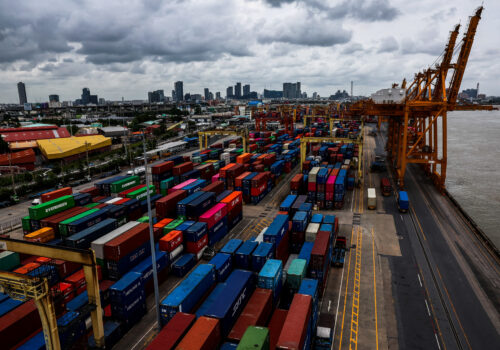The Trump administration needs a strategic reset with India
Today, a 50 percent tariff on most Indian goods went into effect, the latest evidence of how the Trump administration’s attempts at trade diplomacy with India have quietly unraveled into a broader strategic standoff. This development risks compromising decades of work under Republican and Democratic administrations that sought to build a durable US-India strategic relationship to serve, among other things, as a counterweight to a rising China. In its pursuit of a narrowly framed “trade deal,” the administration has overreached, alienating a key partner. In doing so, it has underestimated both the structural sensitivities of the Indian economy and the strategic implications of overreliance on coercive diplomacy.
This deterioration did not arise from a singular policy failure but rather from a pattern: a belief that India, like Japan and the European Union (EU), would ultimately make major concessions affecting sensitive domestic constituencies under US pressure. That miscalculation has proven costly. Unlike Tokyo and Brussels, New Delhi proved unwilling to sacrifice core economic interests or domestic political capital for marginal gains. The Trump administration’s frustration—sharpened by Prime Minister Narendra Modi’s refusal to provide diplomatic cover by crediting President Donald Trump with de-escalating India-Pakistan tensions—led US officials to pivot sharply to a punitive posture. The administration targeted India’s energy trade with Russia, assuming that it would function as diplomatic leverage to achieve progress on Trump’s trade agenda.
But this pressure campaign has not yielded concessions; instead, it has hardened Indian resistance, provoking domestic backlash that recalls worst days of knee-jerk 1970s anti-Americanism. It has stalled bilateral progress on trade, geopolitical, and security cooperation. Worse, it has created the perception of a double standard—one for India, and another for other states, most importantly China, that continue to purchase large volumes of Russian hydrocarbons with little reaction from Washington.
The limits of leverage
The Trump administration’s instinct to use energy trade as a wedge reflects a longstanding assumption in Trump’s Washington: that economic coercion, particularly around sanctions enforcement, can compel alignment even from strategically independent and historically neutral actors. Indeed, throughout its history India has resisted alignment with the interests and policies of other major powers and pursued flexibility in its international relations.
New Delhi’s recent policies dedicated to ensuring its energy security exemplify this approach. As host to the world’s largest refinery, India relies on heavy crude oil feedstocks—feedstocks increasingly unavailable due to successive rounds of US sanctions on Venezuela and Iran. If India were to remove Russian supplies from the mix, this choice would force India into tighter and costlier markets, particularly for Middle Eastern crude. Taken together, these actions would likely raise crude oil prices globally.
That India has continued to import Russian oil while remaining compliant with the Group of Seven (G7) price cap—often with explicit US government encouragement—should have factored into Washington’s responses on unrelated matters such as trade. So too should have the broader global context: China, Turkey, and several EU member states, along with the United States, have continued to purchase Russian hydrocarbons or nuclear fuel. In singling out India for possible secondary tariffs, the administration has exposed the inconsistencies of its own approach. The result has been both diplomatically counterproductive and strategically incoherent. Punishing India’s imports—while tacitly accepting China’s—only reinforces Beijing’s energy advantage through discounted Russian and Venezuelan crude. The current approach serves neither the objective of isolating Russia nor that of countering China, and thus it runs counter to the US government’s own stated priorities.
Undermining a strategic pillar
US strategy in the Indo-Pacific has long been centered on partnership with India. New Delhi is a vital player in the Quadrilateral Security Dialogue, or Quad, as well as on the issue of critical minerals, where India was a first mover in warning of the dangers of overreliance on China-controlled supply chains. Going back to the George W. Bush administration, the United States has sought also to support India’s emergence as a more active force on the international stage as a counterweight to Chinese influence in the Indian Ocean and South Asia. India is also an increasingly important partner for the United States in global technology and defense ecosystems. The present friction threatens US interests in all of these domains.
More dangerously, Washington risks pushing India closer to an informal alignment with China, Russia, and the rest of the BRICS bloc of emerging economies—a development that would severely complicate US efforts to build resilient supply chains, maintain access to critical minerals, and preserve a rules-based order in the Indo-Pacific. New Delhi is not seeking to rupture ties with Washington, but it is asserting its autonomy. By mistaking independence for intransigence, the Trump administration risks undoing a strategic convergence that has taken decades to build through multiple governments in both countries.
The administration’s treatment of trade negotiations as a zero-sum exercise has compounded the problem. For example, agriculture, a key sticking point in talks, is among the most politically sensitive sectors in India’s domestic politics—even more so than it is in Europe or the United States. Both the EU and Japan concluded bilateral trade agreements with Washington that left existing terms around agriculture largely intact. That India has been expected to compromise on this front speaks to a lack of political empathy and strategic consistency. The pursuit of a maximalist trade package, disconnected from broader strategic goals, has been a recipe for failure.
A path forward
What is needed now is not a rhetorical recalibration but a structural one. Washington must move away from coercive bilateralism toward a strategic framework that understands India not as a swing state to be pressured by imposed costs, but as a long-term strategic partner whose alignment will be driven by shared interests.
First, secondary tariffs on Russian oil should be suspended or explicitly exempt India—at least while it remains compliant with the G7 price cap and continues to grow its imports of US energy. Any punitive measures should be applied evenly and with clear strategic purpose. Targeting India alone, while granting de facto exemptions to China, undermines the credibility of US sanctions policy and reinforces the very dependencies Washington seeks to disrupt.
Second, the administration should revive bilateral trade talks—but within a broader strategic context. A new US-India Strategic Dialogue on Trade, Energy, and Technology, co-led by senior officials on both sides, could reframe economic disagreements as part of a wider agenda encompassing energy security, critical technologies, and supply chain resilience. Holding such a dialogue on the margins of the United Nations General Assembly in September would lend it symbolic weight and restore diplomatic momentum.
Third, the administration should immediately revive the US-India CEO Forum, created during the George W. Bush administration, as a means to elevate the voices of the American and Indian business leaders who believe so strongly in each other’s success.
Fourth, Washington should signal that trust-building is a precondition for deeper trade liberalization. That includes recognizing India’s long track record of compliance with US sanctions—even at economic cost—and acknowledging that India’s diversification of energy sources is a net stabilizing factor in global markets, not a liability.
Strategic patience, not tactical pressure
The United States and India are not natural adversaries, but they are not automatic allies either. Their partnership must be managed carefully, with sensitivity to domestic constraints and an appreciation for history. India’s nonalignment during the Cold War was not a signal of hostility but a reflection of its strategic culture—a culture that still informs its decisions today.
For decades, successive US administrations have worked—often quietly, sometimes inconsistently—to build trust with India. The Trump administration now risks undoing the benefits of that progress by mistaking partnership for leverage and confusing short-term optics with long-term alignment.
If Washington’s goal is to secure a reliable partner in Asia, build resilient supply chains, and maintain a strategic coalition capable of containing Chinese influence, then the current approach is unsustainable. A strategic reset is not a concession. It is an investment in credibility—and in the only kind of alliance that can endure; one built on mutual respect.
David L. Goldwyn is chairman of the Atlantic Council’s Energy Advisory Group and a former special envoy for international energy affairs at the US Department of State and assistant secretary of energy for international affairs.
Geoffrey Pyatt is a distinguished fellow at the Atlantic Council’s Global Energy Center. He previously served as assistant secretary of state for energy and natural resources and ambassador to Ukraine and Greece. He also served for seven years at the US embassy in New Delhi, including as deputy chief of mission and charge d’affaires.
Further reading
Wed, Aug 20, 2025
What will the prime minister’s call for a ‘self-reliant India’ mean for New Delhi’s trade and industrial policy?
New Atlanticist By Gopal Nadadur
Prime Minister Narendra Modi recently spoke about a “self-reliant India,” a phrase that has taken on new context following US tariff threats.
Fri, Aug 1, 2025
What to watch as Trump ratchets up global tariffs
Fast Thinking By
US President Donald Trump will raise tariffs on nearly every US trading partner. Atlantic Council experts take stock of what this means for the global economy.
Wed, Aug 6, 2025
US-India trade relations are getting worse. Quality control orders can be part of a reset.
New Atlanticist By Gopal Nadadur
While ostensibly targeted mainly at Chinese dumping, quality control orders often cause “collateral damage” by impacting imports from other economies.
Image: United States President Donald J Trump and Prime Minister Narendra Modi of India hold a joint press conference in the East Room of the White House in Washington, DC, February 13, 2025. Credit: Francis Chung / Pool via REUTERS



